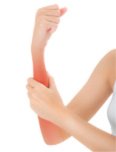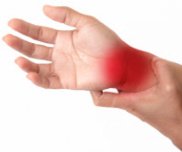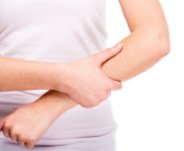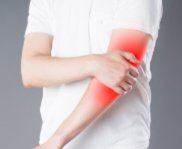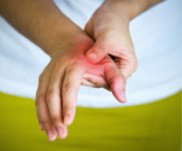Forearm Pain Self Care
Forearm pain self care takes on an interesting twist when you consider the anatomy of the forearms. When you use your hands, muscles on one side of the forearms contract while the muscles on the other side lengthen.
In order for you to be pain free, these muscles must be able to work in a balanced way. So, if one side is tight or adhered, the other side will have to overwork to compensate. This can lead to pain and injury.
Stretching Is The Key To Successful Forearm Pain Self Care
Stretching is the best form of self care to relieve forearm pain. This
encourages fascia that is adhered to release from one another in the
quickest way possible. It's also a great way to balance the function of
the muscles on both sides of the forearms.
It's important to
choose stretching exercises that affect all of the muscles of the
forearms separately. Because your injury has developed as a result of
how you use your hands and arms, it is impossible to tell at the
beginning which muscles are creating your problem. So, choose stretches
that work on all the muscles of the forearms and pay attention to how
they feel as you practice them. This will give you clues as to which
muscles are causing your symptoms.
Forearms Are Connected To The Upper Body By Way Of The Fascia
By way of the fascial matrix in the body, the muscles of the forearm are connected to the upper arms and into the chest, shoulders, back and neck. Often there is a shortening, adhesion, or restriction somewhere in the upper body which then ends up limiting how much the fascia and muscles are free to move down into the forearms. It's as if there isn't enough "slack" in the tissues to allow free and unrestricted range of motion.
For the best in forearm pain self care, it is really important to include stretches that address fascial adhesions in the upper arm, shoulders, armpits, chest and neck when you are dealing with forearm pain. Ignoring these areas will result in less than complete elimination of symptoms.
Eliminate Additional Sources of Pain
If you are looking for truly effective forearm pain self care, then it's time to turn inward and pay attention. To eliminate forearm pain, it's important to identify other sources of forearm strain and try to eliminate as much of that strain as possible.
What are you doing when you feel forearm pain? Do you feel it at work? While playing a sport?
Is your body in a particular position when you feel pain? Noticing the pain signals from your body when you are doing certain activities will help you make changes that are less stressful to your forearm muscles and connective tissues. Overtime, this can have a massive effect on your comfort level.
Very common sources of unnecessary added strain include
- Resting your wrists on the desk surface as you type. This usually causes the extensor muscles to remain in constant contraction.
- Keeping the wrist or elbow bent, especially when you are holding something. The heavier the object, the greater the strain.
- Gripping a tool, instrument, pen or other object with more force than necessary.
If you notice yourself doing any of these activities, or any other kind of holding that you feel in your forearms, figure out a way to limit or eliminate these sources of strain. Doing so will significantly reduce the overall strain in your forearms.
Forearm muscles contract when you move your fingers or bend your wrist. If you use your fingers or wrists extensively in your work, your forearm muscles are already under a lot of strain in the normal course of your day.
Because adhered fascia has the ability to limit the range of motion of muscles that are habitually under strain, it is critically important to systematically release those fascial restrictions in order to bring the forearm muscles back to their optimum ability to fully contract. Choose exercises that bend the wrist or extend or straighten the elbow.
Some Temporary Sacrifices May Be Necessary
For the most effective forearm pain self care, it makes sense to take a good look at all the ways you use your forearm muscles every day. People often don't realize the effect that their choice of sports or hobbies can have on the forearm muscles and fascia.
To avoid further strain, consider eliminating stressful activities like hand-intensive sports and hobbies, at least until your recovery is complete.
Activities like gripping a tennis racket, weight lifting, or grasping the handlebars of a bicycle put a tremendous amount of strain onto the forearm muscles.
Playing a guitar or playing computer games is equally stressful.
Choose only to do the most essential things with your hands and arms while you are trying to recover and your arms will thank you.
As always, consistency and care are the most important concepts to grasp when restoring forearms to normal, pain-free function and range of motion. Pay close attention to the sensations your body sends as you stretch. Never overdo it and never cause pain.
Adequate Water Intake Assists The Recovery Process
Adequate water intake is also very important to add to our self care regimen. Well hydrated fascia allows the flexor and extensor muscles to slide and glide across one another. Imagine how that sliding and gliding would be affected if the tissues are dry and sticky! Movement of individual muscles would be inhibited, strength would be reduced, and pain would eventually become the norm.
|
Looking For The Solution To Your Forearm Pain? Based on my 30+ years of experience, I have put together, just for you, the most effective program ever for correcting Forearm Pain.
Click HERE for all the information that will help you on your healing journey. |
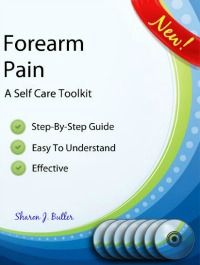 |
To learn more about Forearm Pain Self Care, visit the following sections:
Forearm Pain Anatomy
Forearm Pain Symptoms
What Makes An Effective Stretch?
Click the block below that most closely matches your injury for more information and to find the Toolkit we offer to help you in your recovery.

